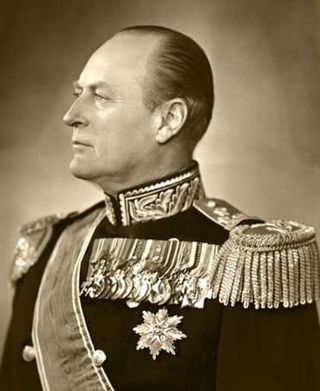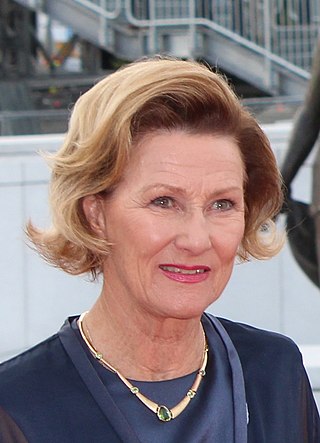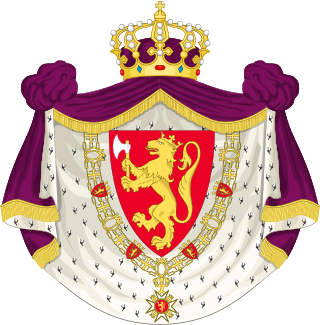The Norwegian order of precedence is the hierarchy of officials in the Government of Norway used to direct seating and ranking on formal occasions, decided by the King, which came into effect from 1 July 1993.
I. The President of the National Assembly, the Prime Minister, the Chief of the Supreme Court, the Vice President of the National Assembly and members of the Cabinet with spouses have, in the Royal Court, rank and seat second to the Royal Family and foreign royal and princely persons. Following these, the Lord Chamberlain, ambassadors of foreign powers, the presidents and vice presidents of the Lagting and Odelsting with spouses.
II. Officials of the Court have rank and file as such:
- The Mistress of the Robes - with generals
- Marshal of the Court, Cabinet Secretary - with lieutenant generals
- Chamberlain, Directors of the Royal Administration, the Royal Household and the King's and the Crown Prince's attendant staff - with major generals.
- Members of The Civil Staff - with brigadiers.
- Dames of the Court - with colonels
III. Bearers of The Royal Norwegian Order of St. Olav's Grand Cross with collar have rank and seat directly after the Mistress of the Robes. Bearers of the War Cross (Krigskorset) with sword, the Medal for Outstanding Civic Achievement (Medaljen for Borgerdåd), the Grand Cross of the Royal Norwegian Order of St. Olav and the Royal Order of Merit's Grand Cross have rank and seat before Marshals of the Court and Cabinet Secretaries.
IV. Civil servants in the State's employment have same rank and seat as dignitaries of the court of the same rank, after seniority. Unranked spouses follow the rank of the ranked spouse.
V. Those by court employed who are given an honourable discharge keep their position's title and rank.
- The King Harald V
- The Queen Sonja
- The Crown Prince Haakon Magnus
- The Crown Princess Mette-Marit
- Princess Ingrid Alexandra
- Prince Svere Magnus
- Princess Martha Louise
- Mr Shaman Durek
- Princess Astrid, Mrs. Ferner
- The President of the National Assembly
- The Prime Minister
- The Chief of the Supreme Court
- The Vice President of the National Assembly
- The Members of the Cabinet:
- Minister of Finance
- Minister of Agriculture and Food
- Minister of Foreign Affairs
- Minister of Research and Higher Education
- Minister of Local Government and Regional Development
- Minister of Defence
- Minister of the Environment and International Development
- Minister of Trade and Industry
- Minister of Labour and Social Inclusion
- Minister of Transport and Communications
- Minister of Justice and the Police
- Minister of Culture and Church Affairs
- Minister of Health and Care Services
- Minister of Government Administration and Reform
- Minister of Petroleum and Energy
- Minister for Children and Equality
- Minister of Education
- Minister of Fisheries and Coastal Affairs
- The Lord Chamberlain
- Ambassadors of foreign powers
- The Mistress of the Robes - with generals
- Bearers of the Royal Norwegian Order of St. Olav with collar
- Bearers of the War Cross (Krigskorset) with sword, the Medal for Civil Accomplishments (Borgerdådsmedaljen), the Grand Cross of the Royal Norwegian Order of St. Olav and the Royal Order of Merit's Grand Cross
- Marshal of the Court, Cabinet Secretary - with lieutenant generals
- Chamberlain, Directors of the Royal Administration, the Royal Household and the King's and the Crown Prince's attendant staff - with major generals.
- Members of The Civil Staff - with brigadiers.
- Dames of the Court - with colonels

Maximilian, Margrave of Baden, also known as Max von Baden, was a German prince, general, and politician. He was heir presumptive to the throne of the Grand Duchy of Baden, and in October and November 1918 briefly served as the last chancellor of the German Empire and minister-president of Prussia. He sued for peace on Germany's behalf at the end of World War I based on U.S. President Woodrow Wilson's Fourteen Points and took steps towards transforming the government into a parliamentary system. As the German Revolution of 1918–1919 spread, he handed over the office of chancellor to SPD Chairman Friedrich Ebert and unilaterally proclaimed the abdication of Emperor Wilhelm II. Both events took place on 9 November 1918, marking the beginning of the Weimar Republic.

Olav V was King of Norway from 1957 until his death in 1991.

Haakon, Crown Prince of Norway is the heir apparent to the Norwegian throne. He is the only son of King Harald V and Queen Sonja.

Sonja is Queen of Norway as the wife of King Harald V.
The following is the order of precedence in England and Wales as of April 2024. Separate orders exist for men and women.

Prince Carl Philip of Sweden, Duke of Värmland is the only son and the second of three children of King Carl XVI Gustaf and Queen Silvia. As of 2022, Prince Carl Philip is fourth in the line of succession, after his older sister, Crown Princess Victoria, his niece and goddaughter Princess Estelle, and his nephew Prince Oscar. He lives with his wife, Princess Sofia, and three sons, Prince Alexander, Prince Gabriel and Prince Julian in Villa Solbacken in Djurgården, Stockholm.
A royal household or imperial household is the residence and administrative headquarters in ancient and post-classical monarchies, and papal household for popes, and formed the basis for the general government of the country as well as providing for the needs of the sovereign and their relations. It was the core of the royal court, though this included many courtiers who were not directly employed by the monarch as part of the household.

The Royal Norwegian Order of Saint Olav is a Norwegian order of chivalry instituted by King Oscar I on 21 August 1847. It is named after King Olav II, known to posterity as St. Olav.

Members of the Norwegian royal family are people related to King Harald V of Norway or former Norwegian monarchs. The current family who holds the throne are members of the House of Glücksburg who ascended to the Norwegian throne after the election of Prince Carl of Denmark as King of Norway during the dissolution of the Swedish-Norwegian union in 1905.

Prince Vanna Vaidhayakara, known in the West as Wan Waithayakon (1891–1976), was a Thai royal prince and diplomat. He was President of the Eleventh Session of the United Nations General Assembly (1956–1957), while serving as Thailand's Permanent Representative to the United Nations. He was a grandson of King Mongkut.

The War Cross with Sword is the highest ranking Norwegian gallantry decoration. It is awarded for extraordinary brave actions or extraordinary leadership during combat. A recipient deemed worthy of additional citations will receive up to an additional two swords on the medal ribbon in addition to the "standard" single sword. Additional citations are rare: Gunnar Sønsteby is the only person to have received the War Cross with three swords.

The Royal Norwegian Order of Merit was instituted by King Olav V in 1985. It is awarded to foreigners, Norwegian citizens living abroad, Ministry of Foreign Affairs diplomats, foreign civil servants in Norway, and Norway's honorary consuls for "outstanding service in the interests of Norway". Its counterpart, the Royal Norwegian Order of St. Olav, is generally only awarded to Norwegian citizens living in Norway.

Prince Harald of Denmark was a member of the Danish Royal Family. He was the third son and fourth child of Frederick VIII of Denmark and his wife, Lovisa of Sweden, and thus brother to Christian X of Denmark and Haakon VII of Norway.
The Danish order of precedence is a symbolic hierarchy of Danish officials used to direct protocol. It has no official status and entails no special privileges, but has been established in practical use, e.g. determining seating arrangements at formal occasions in the royal house. The order of precedence is very elaborate, and especially the lower classes include many relatively obscure civil servant positions; the following is only an excerpt.

Prince Daniel, Duke of Västergötland, is a member of the Swedish royal family by marriage to Victoria, Crown Princess of Sweden making Daniel the likely next prince consort of Sweden. Prior to his marriage to the heir apparent to the Swedish throne, he was a personal trainer and gym owner and ran a company called Balance Training with three gyms in central Stockholm.
Odd Grønvold was a Norwegian royal servant.
Kaare Langlete was a Norwegian military officer and royal servant.

Gustaf VI Adolf was King of Sweden from 29 October 1950 until his death in 1973. He was the eldest son of Gustaf V and his wife, Victoria of Baden. Before Gustaf Adolf ascended the throne, he had been crown prince for nearly 43 years during his father's reign. As king, and shortly before his death, he gave his approval to constitutional changes which removed the Swedish monarchy's last political powers. He was a lifelong amateur archeologist particularly interested in Ancient Italian cultures.

Nikolai Ramm Østgaard, sometimes referred to as N. R. Østgaard, was a Norwegian military officer, aide-de-camp for Olav V of Norway, and sports official who is best known as President of the International Ski Federation (FIS) from 1934 to 1951.













